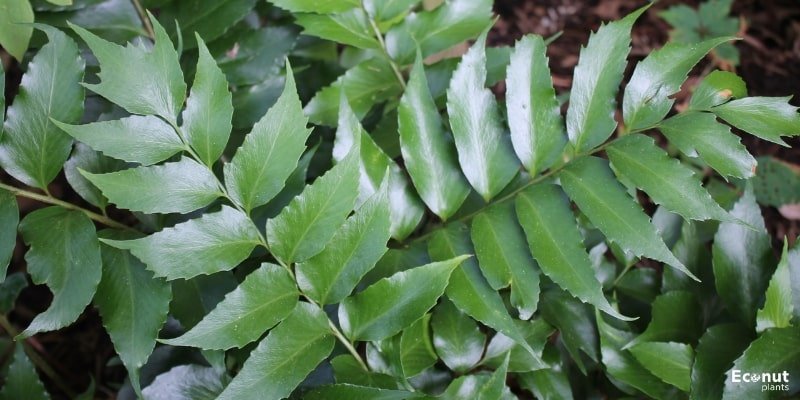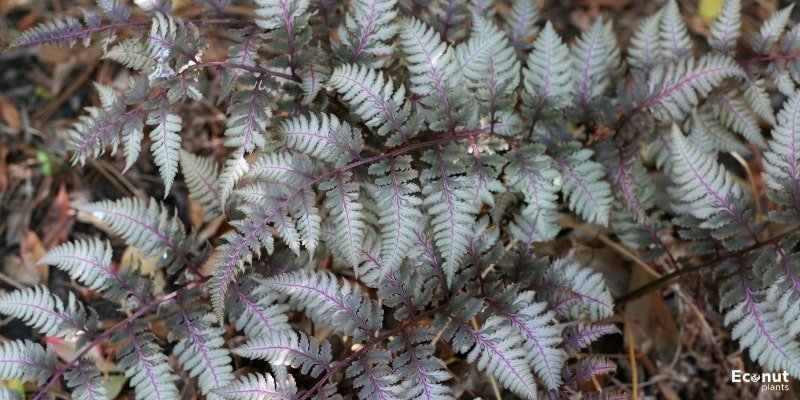Ferns are prized for their lovely leaves and capacity to grow in low light. Numerous varieties of ferns, especially those native to tropical and semi-tropical areas, are suitable for indoor cultivation.
Indoor ferns are easy to grow and require little care if the proper conditions are met. Do you intend to add ferns to your houseplant garden? Ferns come in a wide variety and are excellent houseplants. Here are our top picks for indoor gardens, complete with names, photos, and botanical details!
1. Bird’s Nest Fern

The bird’s nest fern is easier to grow and care for than its more romantic and lush siblings. Think of it as a beginning fern!
It requires one or two weeks of consistent watering and strong, indirect light. The leaves will droop and appear sad, so you’ll know when to water them. Even better news? Pet-friendly houses can safely use them as they are non-toxic.
2. Crocodile Fern

The Crocodile Fern, Microsorum musifolium ‘Crocodyllus,’ is quite well-known online thanks to its intriguing appearance. The plant gets its common name from its wide, floppy fronds, which are lovely in and of themselves and have a pattern like the skin of a crocodile.
They thrive as epiphytes in their natural environments in southeast Asia and Australia, shielded from the harsh shade of towering tree canopies overhead. For these plants to keep their lush foliage, they require plenty of water and humidity.
This implies that, compared to other fern alternatives, they may require more upkeep. For aficionados of ferns and other houseplants, the Crocodile Fern is an essential collectible. Under optimal circumstances, they can grow to a height of 2 to 5 feet, making them your home’s most eye-catching feature.
3. Boston fern

The Boston fern is incredibly resilient and requires little maintenance. It has up to 80 cm-long, pinnate or compound green leaves. When hung ornamentally over the rim of indoor hanging pots, these look fantastic.
Boston ferns grow on the ground or on trees in the wild. They require a sunny area indoors that is shaded from the midday light and consistently warm (18 to 20 °C) throughout the year.
Since Boston ferns also like high humidity, a bathroom is the ideal place for them. For a Boston fern, loose-structured soil with good water retention is optimal. These ferns can grow up to 90 centimetres in height. They have leaflets that are multi-coloured, wavy, or curly in numerous kinds.
4. Macho Fern

The macho fern is not the best choice if you’re seeking a delicate fern. With vivid green fronds that may reach a length of four feet, it certainly lives up to its name. This Florida-native fern looks great as a centrepiece indoors or in hot, muggy outdoor settings. Just make sure to regularly hydrate their soil.
5. Maidenhair Fern

It’s well known that growing maidenhair indoors can be difficult. Their aversion to dryness stems from their preference for high humidity and water content. This plant is for you if you have a habit of overwatering it. With a few daily mists, these ferns will repay you with long, dark, wiry stems with finely textured fronds.
6. Hen and Chickens Fern

This is a different kind of fern with very graceful, arching foliage that may remind you of pine trees. The fronds are light green and separated into many thin, almost needle-like segments. Compared to the ones we have seen thus far, this kind of fern plant will have an entirely different effect on you.
It is perfect as beautiful underbrush or to go with flowering plants in flower beds and borders because of its feathery texture. It can also be used as a light yet rich presence in patios, on terraces, indoors, in pots, or in hanging baskets.
7. Cretan Brake Fern

The Cretan brake, also known as ribbon fern, is distinguished by its graceful silver and green variegations on the fronds. The heart of their light green leaves has a line that transitions from silver to white. The ribbon fern features arching fronds that are oriented opposite one another and contain more than five pinnae each.
Though frost protection is necessary, they can survive well in temperatures over 2 °C. The optimum conditions for growing them indoors in pots are those with some partial sunlight.
8. Silver Brake Fern

Silver brake ferns are adaptable to most houses and make beautiful houseplants. The fronds will turn yellow and die if they are exposed to hot, dry air; they require bright, indirect light and should be maintained away from drafts and vents.
Though you can trim off tall stems to regulate its size, this fern can reach up to 12″ in height. By placing the container on a tray with stones and water, you may keep the soil slightly damp and increase the humidity. You can also sprinkle it frequently.
Every two weeks or so, feed the fern with a half-strength, balanced houseplant fertilizer while it is actively growing. Use it alone or in large quantities to give shaded rock gardens and wooded areas in the garden more interest and texture. It is resilient.
9. Rabbit’s Foot Fern

Davallia fejeensis resembles other ferns in appearance, but it has peculiar claw-like stems that wander over pot edges. The plant, often known as Rabbit’s Foot Fern, gets its name from these modified stems that are covered in silky hairs.
This fern, which is native to Fiji, grows naturally under tree shadow. With its fluffy “feet,” it clings to tree limbs and rocks. The green leaves that emerge from the plant have a delicate cascading style that looks amazing in hanging baskets and pots. The leaves can grow up to one or two feet long.
The fuzzy stems, also known as rhizomes, are a useful water-requirement signal for plants. If they appear a little dry, give them a good soak in water and let the extra run off.
10. Button fern

Another lovely but simple-to-grow plant is ball fern. Originating from New Zealand, it easily adjusts to typical household settings.
Its name comes from the tiny, rounded “buttons,” or leaflets, that are attached to its thin stems. Humidify it to a moderate-to-high degree. It’s a fantastic option for small-space gardeners because it only gets to be 12 to 18 inches tall.
11. Ostrich Fern

The name “deciduous ostrich ferns” (Matteuccia struthiopteris) comes from the way their long, feathery, plume-like fronds arch and have texture.
They grow well in moist gardens and regions that are prone to erosion since they require little care, are disease-free, and thrive in most types of soil. This fern grows well in chilly summer climes; it is not a good choice for southern climates.
12. Holly Fern

This is a fantastic indoor fern that grows nicely in pots. Because ferns can grow in complete shadow, many people grow them as houseplants.
Its foliage might burn in hours of direct sunlight. Furthermore, the evergreen fern will continue to be green throughout the winter.
13. Staghorn Ferns

It is simple to understand how the staghorn fern got its name when you see how it resembles antlers. Even though this species is frequently seen growing on tree bark in Asia, Africa, and Australia, if you plant it in coarse soil with sufficient drainage, it makes a good houseplant.
The fronds of staghorns are divided into two pairs. The green fronds grow up to four feet long, are fertile, and resemble stag horns with spores on the underside. The brown, circular, sterile fronds are short and flat and grow outside the green ones.
14. Delta Maidenhair Fern

The stunning fern variation Adiantum raddianum is native to Tropical America and Mexico. Its delicate fan-shaped fronds and thin, black stalks, which grow straight when young and gradually arch as they develop, give it an exquisite appearance.
Given that maidenhair fern requires a constant supply of moisture, growing it in hot, dry regions can be challenging. View my blog post for a simple method of cultivating maidenhair ferns. It will make things very easy for you!
15. Kangaroo paw

Western Australia is a major exporter of kangaroo paw. Its long, strangely curved fronds spill over and down the sides of its container as it grows to a height of around 2 feet.
Outside, kangaroo ferns bloom throughout the spring and summer, but they can also bloom at any time of year under the correct circumstances.
16. Autumn Fern

The autumn fern, or Dryopteris erythrosora, lives up to its name, displaying bronze tones reminiscent of fall. It also has beautiful springtime coppery-green fronds that turn a brighter green in the summer.
Hardy in Zones 5–9 provides these vibrant ferns with partial to complete shade and protects plants from intense winds and prolonged exposure to direct sunshine.
When new growth occurs, feed them as directed by the product, using a slow-release fertilizer. Grown in rich, wet, somewhat acidic soil, autumn ferns reach heights of 24 to 30 inches. Evergreen in locations without frost can be deciduous or semi-evergreen in areas with harsh winters, depending on how low the temperatures drop.
17. Painted Lady Fern

The painted lady fern is closely related to the lady fern, which is amazing with its silver grey foliage; nevertheless, the fronds of this fern variant have a beautiful burgundy purple colour.
However, the impact doesn’t stop here. The fronds become silver green as they get older, creating a striking contrast between the younger, burgundy stems and the lower, older foliage.
When paired with different shades of green, off white, or purple, this particular type of fern may create an amazing chromatic effect that makes it look like a real-life Christmas ornament. You are capable of setting incredible boundaries.
18. Cotton Candy Boston Fern

Because they don’t mind being neglected and receiving regular hydration and bright, indirect light, Boston ferns make great houseplants.
When mature, they can grow to be rather huge and have fronds with a coarse texture. Certain types maintain their modest size (such as the ‘Cotton Candy’ variety, pictured below, which we adore for it’s exceptionally fine and fluffy fronds).
19. Foxtail Fern

Another fern impostor is the foxtail fern (Asparagus densiflorus). However, this rich, feathery perennial evergreen herb is more often planted outdoors than indoors, unlike asparagus ferns.
It also bears small white blossoms that, in the fall, develop into eye-catching crimson berries. Both humans and animals can be somewhat poisoned by foxtail fern.
20. Tricolour Fern

This specimen features the conventional fern design with its graceful pinnate leaves, but what really stands out is the brilliant spectrum of hues it displays, which include scarlet, gold, and bright green all on one plant.
The Boston fern requires similar care, including filtered light, high humidity, moist soil, and mild temperatures. Divide and replant tricolour ferns, another quick grower, in a pot every spring using new, well-draining potting soil.
21. Fishtail Fern

Nephrolepis falcata, also called the Fishtail Sword Fern, has huge leaves that resemble Boston ferns. The fronds have a unique fishtail look at the ends and tumble over pots and hanging baskets in a lush cluster.
Reaching an astounding 3 feet long and 7 feet wide, the fishtail fern plant can grow enormously. Give them lots of space to grow if you intend to grow them inside a pot.
They are ideal patio or balcony plants in tropical and subtropical temperatures, such as those found in their native southern Asia, Malaysia, and the Philippines. They grow best inside a warm, sunny space that is free from drafts in colder climates.

